Deck 3: Interdependence and the Gains from Trade.
Question
Question
Question
Question
Question
Question
Question
Question
Question
Question
Question
Question
Question
Question
Question
Question
Question
Question
Question
Question
Question
Question
Question
Question
Question
Question
Question
Question
Question
Question
Question
Question
Question
Question
Question
Question
Question
Question
Question
Question
Question
Question
Question
Question
Question
Question
Question
Question
Question
Question
Question
Question
Question
Question
Question
Question
Question
Question
Question
Question
Question
Question
Question
Question
Question
Question
Question
Question
Question
Question
Question
Question
Question
Question
Question
Question
Question
Question
Question
Question

Unlock Deck
Sign up to unlock the cards in this deck!
Unlock Deck
Unlock Deck
1/443
Play
Full screen (f)
Deck 3: Interdependence and the Gains from Trade.
1
As a student,Anne spends 40 hours per week writing term papers and completing homework assignments.On one axis of her production possibilities frontier is measured the number of term papers written per week.On the other axis is measured the number of homework assignments completed per week.Anne's production possibilities frontier is a straight line if
A) she faces no trade-off between writing term papers and completing homework assignments.
B) she can switch between writing term papers and completing homework assignments at a constant rate.
C) the rate at which she can switch between homework assignments and term papers depends on the number of homework assignments she is completing and on the number of term papers she is writing.
D) she is required by her professors to spend half of her time on term papers and the other half of her time on homework assignments.
A) she faces no trade-off between writing term papers and completing homework assignments.
B) she can switch between writing term papers and completing homework assignments at a constant rate.
C) the rate at which she can switch between homework assignments and term papers depends on the number of homework assignments she is completing and on the number of term papers she is writing.
D) she is required by her professors to spend half of her time on term papers and the other half of her time on homework assignments.
B
2
Consider two individuals - Marquis and Serena - each of whom would like to wear sweaters and eat tasty food.The gains from trade between Marquis and Serena are most obvious in which of the following cases?
A) Marquis is very good at knitting sweaters and at cooking tasty food, but Serena's skills in both of these activities are very poor.
B) Marquis and Serena both are very good at cooking tasty food, but neither has the necessary skills to knit a sweater.
C) Marquis's cooking and knitting skills are very poor, and Serena's cooking and knitting skills are also very poor.
D) Marquis's skills are such that he can produce only sweaters, and Serena's skills are such that she can produce only tasty food.
A) Marquis is very good at knitting sweaters and at cooking tasty food, but Serena's skills in both of these activities are very poor.
B) Marquis and Serena both are very good at cooking tasty food, but neither has the necessary skills to knit a sweater.
C) Marquis's cooking and knitting skills are very poor, and Serena's cooking and knitting skills are also very poor.
D) Marquis's skills are such that he can produce only sweaters, and Serena's skills are such that she can produce only tasty food.
D
3
A production possibilities frontier is a straight line when
A) the more resources the economy uses to produce one good, the fewer resources it has available to produce the other good.
B) an economy is interdependent and engaged in trade instead of self-sufficient.
C) the rate of tradeoff between the two goods being produced is constant.
D) the rate of tradeoff between the two goods being produced depends on how much of each good is being produced.
A) the more resources the economy uses to produce one good, the fewer resources it has available to produce the other good.
B) an economy is interdependent and engaged in trade instead of self-sufficient.
C) the rate of tradeoff between the two goods being produced is constant.
D) the rate of tradeoff between the two goods being produced depends on how much of each good is being produced.
C
4
A certain cowboy spends 10 hours per day mending fences and herding cattle.For the cowboy,a graph that shows his various possible mixes of output (fences mended per day and cattle herded per day)is called his
A) line of tastes.
B) trade-off curve.
C) production possibilities frontier.
D) consumption possibilities frontier.
A) line of tastes.
B) trade-off curve.
C) production possibilities frontier.
D) consumption possibilities frontier.

Unlock Deck
Unlock for access to all 443 flashcards in this deck.
Unlock Deck
k this deck
5
A production possibilities frontier is bowed outward when
A) the more resources the economy uses to produce one good, the fewer resources it has available to produce the other good.
B) an economy is self-sufficient instead of interdependent and engaged in trade.
C) the rate of tradeoff between the two goods being produced is constant.
D) the rate of tradeoff between the two goods being produced depends on how much of each good is being produced.
A) the more resources the economy uses to produce one good, the fewer resources it has available to produce the other good.
B) an economy is self-sufficient instead of interdependent and engaged in trade.
C) the rate of tradeoff between the two goods being produced is constant.
D) the rate of tradeoff between the two goods being produced depends on how much of each good is being produced.

Unlock Deck
Unlock for access to all 443 flashcards in this deck.
Unlock Deck
k this deck
6
People who provide you with goods and services
A) are acting out of generosity.
B) do so because they get something in return.
C) have chosen not to become interdependent.
D) are required to do so by the government.
A) are acting out of generosity.
B) do so because they get something in return.
C) have chosen not to become interdependent.
D) are required to do so by the government.

Unlock Deck
Unlock for access to all 443 flashcards in this deck.
Unlock Deck
k this deck
7
Suppose there are only two people in the world.Each person's production possibilities frontier also represents his or her consumption possibilities when
A) neither person faces trade-offs.
B) the frontiers are straight lines.
C) the frontiers are bowed out.
D) they choose not to trade with one another.
A) neither person faces trade-offs.
B) the frontiers are straight lines.
C) the frontiers are bowed out.
D) they choose not to trade with one another.

Unlock Deck
Unlock for access to all 443 flashcards in this deck.
Unlock Deck
k this deck
8
Which of the following is not a reason people choose to depend on others for goods and services?
A) to improve their lives
B) to allow them to enjoy a greater variety of goods and services
C) to consume more of each good without working any more hours
D) to allow people to produce outside their production possibilities frontiers
A) to improve their lives
B) to allow them to enjoy a greater variety of goods and services
C) to consume more of each good without working any more hours
D) to allow people to produce outside their production possibilities frontiers

Unlock Deck
Unlock for access to all 443 flashcards in this deck.
Unlock Deck
k this deck
9
When an economist points out that you and millions of other people are interdependent,he or she is referring to the fact that we all
A) rely upon the government to provide us with the basic necessities of life.
B) rely upon one another for the goods and services we consume.
C) have similar tastes and abilities.
D) are concerned about one another's well-being.
A) rely upon the government to provide us with the basic necessities of life.
B) rely upon one another for the goods and services we consume.
C) have similar tastes and abilities.
D) are concerned about one another's well-being.

Unlock Deck
Unlock for access to all 443 flashcards in this deck.
Unlock Deck
k this deck
10
Regan grows flowers and makes ceramic vases.Jayson also grows flowers and makes ceramic vases,but Regan is better at producing both goods.In this case,trade could
A) benefit both Jayson and Regan.
B) benefit Jayson, but not Regan.
C) benefit Regan, but not Jayson.
D) benefit neither Jayson nor Regan.
A) benefit both Jayson and Regan.
B) benefit Jayson, but not Regan.
C) benefit Regan, but not Jayson.
D) benefit neither Jayson nor Regan.

Unlock Deck
Unlock for access to all 443 flashcards in this deck.
Unlock Deck
k this deck
11
An economy's production possibilities frontier is also its consumption possibilities frontier
A) under all circumstances.
B) under no circumstances.
C) when the economy is self-sufficient.
D) when the rate of tradeoff between the two goods being produced is constant.
A) under all circumstances.
B) under no circumstances.
C) when the economy is self-sufficient.
D) when the rate of tradeoff between the two goods being produced is constant.

Unlock Deck
Unlock for access to all 443 flashcards in this deck.
Unlock Deck
k this deck
12
The production possibilities frontier illustrates
A) the combinations of output that an economy should produce.
B) the combinations of output that an economy should consume.
C) the combinations of output that an economy can produce.
D) All of the above are correct.
A) the combinations of output that an economy should produce.
B) the combinations of output that an economy should consume.
C) the combinations of output that an economy can produce.
D) All of the above are correct.

Unlock Deck
Unlock for access to all 443 flashcards in this deck.
Unlock Deck
k this deck
13
Table 3-1
Assume that Andia and Zardia can switch between producing wheat and producing beef at a constant rate.

Refer to Table 3-1.Which of the following combinations of wheat and beef could Andia produce in one 8-hour day?
A) 6 bushels of wheat and 35 pounds of beef
B) 9 bushels of wheat and 25 pounds of beef
C) 15 bushels of wheat and 20 pounds of beef
D) 24 bushels of wheat and 40 pounds of beef
Assume that Andia and Zardia can switch between producing wheat and producing beef at a constant rate.

Refer to Table 3-1.Which of the following combinations of wheat and beef could Andia produce in one 8-hour day?
A) 6 bushels of wheat and 35 pounds of beef
B) 9 bushels of wheat and 25 pounds of beef
C) 15 bushels of wheat and 20 pounds of beef
D) 24 bushels of wheat and 40 pounds of beef

Unlock Deck
Unlock for access to all 443 flashcards in this deck.
Unlock Deck
k this deck
14
When can two countries gain from trading two goods?
A) when the first country can only produce the first good and the second country can only produce the second good
B) when the first country can produce both goods, but can only produce the second good at great cost, and the second country can produce both goods, but can only produce the first good at great cost
C) when the first country is better at producing both goods and the second country is worse at producing both goods
D) Two countries could gain from trading two goods under all of the above conditions.
A) when the first country can only produce the first good and the second country can only produce the second good
B) when the first country can produce both goods, but can only produce the second good at great cost, and the second country can produce both goods, but can only produce the first good at great cost
C) when the first country is better at producing both goods and the second country is worse at producing both goods
D) Two countries could gain from trading two goods under all of the above conditions.

Unlock Deck
Unlock for access to all 443 flashcards in this deck.
Unlock Deck
k this deck
15
Ben bakes bread and Shawna knits sweaters.Ben and Shawna both like to eat bread and wear sweaters.In which of the following cases is it impossible for both Ben and Shawna to benefit from trade?
A) Ben cannot knit sweaters and Shawna cannot bake bread.
B) Ben is better than Shawna at baking bread and Shawna is better than Ben at knitting sweaters.
C) Ben is better than Shawna at baking bread and at knitting sweaters.
D) Both Ben and Shawna can benefit from trade in all of the above cases.
A) Ben cannot knit sweaters and Shawna cannot bake bread.
B) Ben is better than Shawna at baking bread and Shawna is better than Ben at knitting sweaters.
C) Ben is better than Shawna at baking bread and at knitting sweaters.
D) Both Ben and Shawna can benefit from trade in all of the above cases.

Unlock Deck
Unlock for access to all 443 flashcards in this deck.
Unlock Deck
k this deck
16
Pocoyo bakes cookies and Pato grows vegetables.In which of the following cases is it impossible for both Pocoyo and Pato to benefit from trade?
A) Pocoyo does not like vegetables and Pato does not like cookies.
B) Pocoyo is better than Pato at baking cookies and Pato is better than Pocoyo at growing vegetables.
C) Pato is better than Pocoyo at baking cookies and at growing vegetables.
D) Both Pocoyo and Pato can benefit from trade in all of the above cases.
A) Pocoyo does not like vegetables and Pato does not like cookies.
B) Pocoyo is better than Pato at baking cookies and Pato is better than Pocoyo at growing vegetables.
C) Pato is better than Pocoyo at baking cookies and at growing vegetables.
D) Both Pocoyo and Pato can benefit from trade in all of the above cases.

Unlock Deck
Unlock for access to all 443 flashcards in this deck.
Unlock Deck
k this deck
17
Consider two individuals - Howard and Mai - each of whom would like to wear sweaters and eat tasty food.The gains from trade between Howard and Mai are least obvious in which of the following cases?
A) Howard is very good at knitting sweaters and at cooking tasty food, but Mai's skills in both of these activities are very poor.
B) Howard is very good at knitting sweaters and at cooking tasty food; Mai is very good at knitting sweaters, but she knows nothing about cooking tasty food.
C) Howard's skills in knitting sweaters are fairly good, but his skills in cooking tasty food are fairly bad; Mai's skills in knitting sweaters are fairly bad, but her skills in cooking tasty food are fairly good.
D) Howard's skills are such that he can produce only sweaters, and Mai's skills are such that she can produce only tasty food.
A) Howard is very good at knitting sweaters and at cooking tasty food, but Mai's skills in both of these activities are very poor.
B) Howard is very good at knitting sweaters and at cooking tasty food; Mai is very good at knitting sweaters, but she knows nothing about cooking tasty food.
C) Howard's skills in knitting sweaters are fairly good, but his skills in cooking tasty food are fairly bad; Mai's skills in knitting sweaters are fairly bad, but her skills in cooking tasty food are fairly good.
D) Howard's skills are such that he can produce only sweaters, and Mai's skills are such that she can produce only tasty food.

Unlock Deck
Unlock for access to all 443 flashcards in this deck.
Unlock Deck
k this deck
18
Table 3-1
Assume that Andia and Zardia can switch between producing wheat and producing beef at a constant rate.

Refer to Table 3-1.Assume that Andia and Zardia each has 360 minutes available.If each person divides his time equally between the production of wheat and beef,then total production is
A) 10.5 bushels of wheat and 16.5 pounds of beef.
B) 21 bushels of wheat and 33 pounds of beef.
C) 35 bushels of wheat and 22 pounds of beef.
D) 42 bushels of wheat and 66 pounds of beef.
Assume that Andia and Zardia can switch between producing wheat and producing beef at a constant rate.

Refer to Table 3-1.Assume that Andia and Zardia each has 360 minutes available.If each person divides his time equally between the production of wheat and beef,then total production is
A) 10.5 bushels of wheat and 16.5 pounds of beef.
B) 21 bushels of wheat and 33 pounds of beef.
C) 35 bushels of wheat and 22 pounds of beef.
D) 42 bushels of wheat and 66 pounds of beef.

Unlock Deck
Unlock for access to all 443 flashcards in this deck.
Unlock Deck
k this deck
19
The most obvious benefit of specialization and trade is that they allow us to
A) work more hours per week than we otherwise would be able to work.
B) consume more goods than we otherwise would be able to consume.
C) spend more money on goods that are beneficial to society, and less money on goods that are harmful to society.
D) consume more goods by forcing people in other countries to consume fewer goods.
A) work more hours per week than we otherwise would be able to work.
B) consume more goods than we otherwise would be able to consume.
C) spend more money on goods that are beneficial to society, and less money on goods that are harmful to society.
D) consume more goods by forcing people in other countries to consume fewer goods.

Unlock Deck
Unlock for access to all 443 flashcards in this deck.
Unlock Deck
k this deck
20
For a self-sufficient producer,the production possibilities frontier
A) is the same as the consumption possibilities frontier.
B) is greater than the consumption possibilities frontier.
C) is less than the consumption possibilities frontier.
D) is always a straight line.
A) is the same as the consumption possibilities frontier.
B) is greater than the consumption possibilities frontier.
C) is less than the consumption possibilities frontier.
D) is always a straight line.

Unlock Deck
Unlock for access to all 443 flashcards in this deck.
Unlock Deck
k this deck
21
Table 3-6
Assume that Maya and Miguel can switch between producing mixers and producing toasters at a constant rate.

Refer to Table 3-6.Which of the following combinations of mixers and toasters could Maya produce in 40 hours?
A) 1 mixers and 7 toasters.
B) 2 mixers and 5 toasters.
C) 2.5 mixers and 4 toasters.
D) 3 mixers and 4 toasters.
Assume that Maya and Miguel can switch between producing mixers and producing toasters at a constant rate.

Refer to Table 3-6.Which of the following combinations of mixers and toasters could Maya produce in 40 hours?
A) 1 mixers and 7 toasters.
B) 2 mixers and 5 toasters.
C) 2.5 mixers and 4 toasters.
D) 3 mixers and 4 toasters.

Unlock Deck
Unlock for access to all 443 flashcards in this deck.
Unlock Deck
k this deck
22
Table 3-3
Assume that Zimbabwe and Portugal can switch between producing toothbrushes and producing hairbrushes at a constant rate.

Refer to Table 3-3.Assume that Zimbabwe and Portugal each has 180 machine minutes available.If each country divides its time equally between the production of toothbrushes and hairbrushes,then total production is
A) 24 toothbrushes and 12 hairbrushes.
B) 48 toothbrushes and 24 hairbrushes.
C) 96 toothbrushes and 48 hairbrushes.
D) 720 toothbrushes and 1440 hairbrushes.
Assume that Zimbabwe and Portugal can switch between producing toothbrushes and producing hairbrushes at a constant rate.

Refer to Table 3-3.Assume that Zimbabwe and Portugal each has 180 machine minutes available.If each country divides its time equally between the production of toothbrushes and hairbrushes,then total production is
A) 24 toothbrushes and 12 hairbrushes.
B) 48 toothbrushes and 24 hairbrushes.
C) 96 toothbrushes and 48 hairbrushes.
D) 720 toothbrushes and 1440 hairbrushes.

Unlock Deck
Unlock for access to all 443 flashcards in this deck.
Unlock Deck
k this deck
23
Table 3-6
Assume that Maya and Miguel can switch between producing mixers and producing toasters at a constant rate.

Refer to Table 3-6.Assume that Maya and Miguel each has 40 hours available.If each person divides his/her time equally between the production of mixers and toasters,then total production is
A) 2 mixer and 8 toasters.
B) 3.5 mixers and 6 toasters.
C) 5 mixers and 4 toasters.
D) 7 mixers and 12 toasters.
Assume that Maya and Miguel can switch between producing mixers and producing toasters at a constant rate.

Refer to Table 3-6.Assume that Maya and Miguel each has 40 hours available.If each person divides his/her time equally between the production of mixers and toasters,then total production is
A) 2 mixer and 8 toasters.
B) 3.5 mixers and 6 toasters.
C) 5 mixers and 4 toasters.
D) 7 mixers and 12 toasters.

Unlock Deck
Unlock for access to all 443 flashcards in this deck.
Unlock Deck
k this deck
24
Table 3-5
Assume that England and Spain can switch between producing cheese and producing bread at a constant rate.

Refer to Table 3-5.Which of the following combinations of cheese and bread could Spain produce in 40 hours?
A) 2.25 units of cheese and 4 units of bread.
B) 5.5 units of cheese and 3 units of bread.
C) 7 units of cheese and 1.5 units of bread.
D) 10 units of cheese and 5 units of bread.
Assume that England and Spain can switch between producing cheese and producing bread at a constant rate.

Refer to Table 3-5.Which of the following combinations of cheese and bread could Spain produce in 40 hours?
A) 2.25 units of cheese and 4 units of bread.
B) 5.5 units of cheese and 3 units of bread.
C) 7 units of cheese and 1.5 units of bread.
D) 10 units of cheese and 5 units of bread.

Unlock Deck
Unlock for access to all 443 flashcards in this deck.
Unlock Deck
k this deck
25
Table 3-6
Assume that Maya and Miguel can switch between producing mixers and producing toasters at a constant rate.

Refer to Table 3-6.Which of the following combinations of mixers and toasters could Miguel not produce in 90 hours?
A) 0 mixers and 4 toasters.
B) 1 mixer and 3 toasters.
C) 0.75 mixers and 2.5 toasters.
D) 2 mixers and 0 toasters.
Assume that Maya and Miguel can switch between producing mixers and producing toasters at a constant rate.

Refer to Table 3-6.Which of the following combinations of mixers and toasters could Miguel not produce in 90 hours?
A) 0 mixers and 4 toasters.
B) 1 mixer and 3 toasters.
C) 0.75 mixers and 2.5 toasters.
D) 2 mixers and 0 toasters.

Unlock Deck
Unlock for access to all 443 flashcards in this deck.
Unlock Deck
k this deck
26
Table 3-2
Assume that Aruba and Iceland can switch between producing coolers and producing radios at a constant rate.

Refer to Table 3-2.Which of the following represents Aruba's production possibilities frontier when 100 labor hours are available?
A)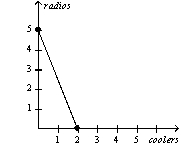
B)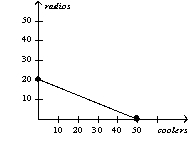
C)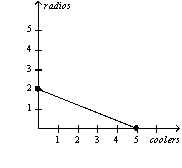
D)
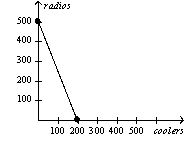
Assume that Aruba and Iceland can switch between producing coolers and producing radios at a constant rate.

Refer to Table 3-2.Which of the following represents Aruba's production possibilities frontier when 100 labor hours are available?
A)

B)

C)

D)


Unlock Deck
Unlock for access to all 443 flashcards in this deck.
Unlock Deck
k this deck
27
Table 3-4
Assume that the farmer and the rancher can switch between producing meat and producing potatoes at a constant rate.

Refer to Table 3-4.Which of the following combinations of meat and potatoes could the farmer produce in 24 hours?
A) 1 pound of meat and 8 pounds of potatoes.
B) 2 pounds of meat and 5 pounds of potatoes.
C) 3 pounds of meat and 12 pounds of potatoes.
D) 4 pounds of meat and 8 pounds of potatoes.
Assume that the farmer and the rancher can switch between producing meat and producing potatoes at a constant rate.

Refer to Table 3-4.Which of the following combinations of meat and potatoes could the farmer produce in 24 hours?
A) 1 pound of meat and 8 pounds of potatoes.
B) 2 pounds of meat and 5 pounds of potatoes.
C) 3 pounds of meat and 12 pounds of potatoes.
D) 4 pounds of meat and 8 pounds of potatoes.

Unlock Deck
Unlock for access to all 443 flashcards in this deck.
Unlock Deck
k this deck
28
Table 3-5
Assume that England and Spain can switch between producing cheese and producing bread at a constant rate.

Refer to Table 3-5.We could use the information in the table to draw a production possibilities frontier for England and a second production possibilities frontier for Spain.If we were to do this,measuring cheese along the horizontal axis,then
A) the slope of England's production possibilities frontier would be -4 and the slope of Spain's production possibilities frontier would be -2.
B) the slope of England's production possibilities frontier would be -0.25 and the slope of Spain's production possibilities frontier would be -0.5.
C) the slope of England's production possibilities frontier would be 0.25 and the slope of Spain's production possibilities frontier would be 0.5.
D) the slope of England's production possibilities frontier would be 4 and the slope of Spain's production possibilities frontier would be 2.
Assume that England and Spain can switch between producing cheese and producing bread at a constant rate.

Refer to Table 3-5.We could use the information in the table to draw a production possibilities frontier for England and a second production possibilities frontier for Spain.If we were to do this,measuring cheese along the horizontal axis,then
A) the slope of England's production possibilities frontier would be -4 and the slope of Spain's production possibilities frontier would be -2.
B) the slope of England's production possibilities frontier would be -0.25 and the slope of Spain's production possibilities frontier would be -0.5.
C) the slope of England's production possibilities frontier would be 0.25 and the slope of Spain's production possibilities frontier would be 0.5.
D) the slope of England's production possibilities frontier would be 4 and the slope of Spain's production possibilities frontier would be 2.

Unlock Deck
Unlock for access to all 443 flashcards in this deck.
Unlock Deck
k this deck
29
Table 3-5
Assume that England and Spain can switch between producing cheese and producing bread at a constant rate.

Refer to Table 3-5.Assume that England and Spain each has 40 labor hours available.If each country divides its time equally between the production of cheese and bread,then total production is
A) 20 units of cheese and 5 units of bread.
B) 25 units of cheese and 7.5 units of bread.
C) 40 units of cheese and 10 units of bread.
D) 50 units of cheese and 15 units of bread.
Assume that England and Spain can switch between producing cheese and producing bread at a constant rate.

Refer to Table 3-5.Assume that England and Spain each has 40 labor hours available.If each country divides its time equally between the production of cheese and bread,then total production is
A) 20 units of cheese and 5 units of bread.
B) 25 units of cheese and 7.5 units of bread.
C) 40 units of cheese and 10 units of bread.
D) 50 units of cheese and 15 units of bread.

Unlock Deck
Unlock for access to all 443 flashcards in this deck.
Unlock Deck
k this deck
30
Table 3-2
Assume that Aruba and Iceland can switch between producing coolers and producing radios at a constant rate.

Refer to Table 3-2.Which of the following combinations of coolers and radios could Aruba produce in one 40-hour week?
A) 3 coolers and 7 radios
B) 5 coolers and 6 radios
C) 11 coolers and 4 radios
D) 13 coolers and 3 radios
Assume that Aruba and Iceland can switch between producing coolers and producing radios at a constant rate.

Refer to Table 3-2.Which of the following combinations of coolers and radios could Aruba produce in one 40-hour week?
A) 3 coolers and 7 radios
B) 5 coolers and 6 radios
C) 11 coolers and 4 radios
D) 13 coolers and 3 radios

Unlock Deck
Unlock for access to all 443 flashcards in this deck.
Unlock Deck
k this deck
31
Table 3-4
Assume that the farmer and the rancher can switch between producing meat and producing potatoes at a constant rate.

Refer to Table 3-4.Which of the following combinations of meat and potatoes could the rancher not produce in 24 hours?
A) 2 pounds of meat and 3 pounds of potatoes.
B) 4 pounds of meat and 2 pounds of potatoes.
C) 6 pounds of meat and 1 pounds of potatoes.
D) 8 pounds of meat and 0.5 pound of potatoes.
Assume that the farmer and the rancher can switch between producing meat and producing potatoes at a constant rate.

Refer to Table 3-4.Which of the following combinations of meat and potatoes could the rancher not produce in 24 hours?
A) 2 pounds of meat and 3 pounds of potatoes.
B) 4 pounds of meat and 2 pounds of potatoes.
C) 6 pounds of meat and 1 pounds of potatoes.
D) 8 pounds of meat and 0.5 pound of potatoes.

Unlock Deck
Unlock for access to all 443 flashcards in this deck.
Unlock Deck
k this deck
32
Table 3-3
Assume that Zimbabwe and Portugal can switch between producing toothbrushes and producing hairbrushes at a constant rate.

Refer to Table 3-3.Which of the following combinations of toothbrushes and hairbrushes could Zimbabwe not produce in 120 minutes?
A) 5 toothbrushes and 11 hairbrushes
B) 10 toothbrushes and 9 hairbrushes
C) 20 toothbrushes and 6 hairbrushes
D) 30 toothbrushes and 3 hairbrushes
Assume that Zimbabwe and Portugal can switch between producing toothbrushes and producing hairbrushes at a constant rate.

Refer to Table 3-3.Which of the following combinations of toothbrushes and hairbrushes could Zimbabwe not produce in 120 minutes?
A) 5 toothbrushes and 11 hairbrushes
B) 10 toothbrushes and 9 hairbrushes
C) 20 toothbrushes and 6 hairbrushes
D) 30 toothbrushes and 3 hairbrushes

Unlock Deck
Unlock for access to all 443 flashcards in this deck.
Unlock Deck
k this deck
33
Table 3-2
Assume that Aruba and Iceland can switch between producing coolers and producing radios at a constant rate.

Refer to Table 3-2.Which of the following represents Iceland's production possibilities frontier when 100 labor hours are available?
A)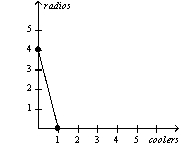
B)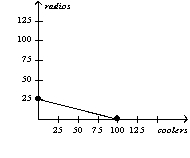
C)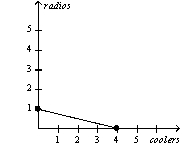
D)
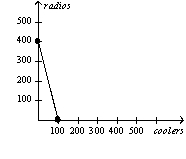
Assume that Aruba and Iceland can switch between producing coolers and producing radios at a constant rate.

Refer to Table 3-2.Which of the following represents Iceland's production possibilities frontier when 100 labor hours are available?
A)

B)

C)

D)


Unlock Deck
Unlock for access to all 443 flashcards in this deck.
Unlock Deck
k this deck
34
Table 3-1
Assume that Andia and Zardia can switch between producing wheat and producing beef at a constant rate.

Refer to Table 3-1.Which of the following combinations of wheat and beef could Zardia not produce in one 10-hour day?
A) 10 bushels of wheat and 45 pounds of beef
B) 20 bushels of wheat and 30 pounds of beef
C) 25 bushels of wheat and 25 pounds of beef
D) 30 bushels of wheat and 15 pounds of beef
Assume that Andia and Zardia can switch between producing wheat and producing beef at a constant rate.

Refer to Table 3-1.Which of the following combinations of wheat and beef could Zardia not produce in one 10-hour day?
A) 10 bushels of wheat and 45 pounds of beef
B) 20 bushels of wheat and 30 pounds of beef
C) 25 bushels of wheat and 25 pounds of beef
D) 30 bushels of wheat and 15 pounds of beef

Unlock Deck
Unlock for access to all 443 flashcards in this deck.
Unlock Deck
k this deck
35
Table 3-2
Assume that Aruba and Iceland can switch between producing coolers and producing radios at a constant rate.

Refer to Table 3-2.Assume that Aruba and Iceland each has 80 labor hours available.If each country divides its time equally between the production of coolers and radios,then total production is
A) 28 coolers and 50 radios.
B) 30 coolers and 9 radios.
C) 60 coolers and 18 radios.
D) 120 coolers and 36 radios.
Assume that Aruba and Iceland can switch between producing coolers and producing radios at a constant rate.

Refer to Table 3-2.Assume that Aruba and Iceland each has 80 labor hours available.If each country divides its time equally between the production of coolers and radios,then total production is
A) 28 coolers and 50 radios.
B) 30 coolers and 9 radios.
C) 60 coolers and 18 radios.
D) 120 coolers and 36 radios.

Unlock Deck
Unlock for access to all 443 flashcards in this deck.
Unlock Deck
k this deck
36
Table 3-3
Assume that Zimbabwe and Portugal can switch between producing toothbrushes and producing hairbrushes at a constant rate.

Refer to Table 3-3.Which of the following combinations of toothbrushes and hairbrushes could Portugal produce in 30 minutes?
A) 1 toothbrush and 4 hairbrushes
B) 4 toothbrushes and 2 hairbrushes
C) 5 toothbrushes and 6 hairbrushes
D) 6 toothbrushes and 5 hairbrushes
Assume that Zimbabwe and Portugal can switch between producing toothbrushes and producing hairbrushes at a constant rate.

Refer to Table 3-3.Which of the following combinations of toothbrushes and hairbrushes could Portugal produce in 30 minutes?
A) 1 toothbrush and 4 hairbrushes
B) 4 toothbrushes and 2 hairbrushes
C) 5 toothbrushes and 6 hairbrushes
D) 6 toothbrushes and 5 hairbrushes

Unlock Deck
Unlock for access to all 443 flashcards in this deck.
Unlock Deck
k this deck
37
Table 3-4
Assume that the farmer and the rancher can switch between producing meat and producing potatoes at a constant rate.

Refer to Table 3-4.Assume that the farmer and the rancher each has 24 labor hours available.If each person divides his time equally between the production of meat and potatoes,then total production is
A) 3 pounds of meat and 12 pounds of potatoes.
B) 5.5 pounds of meat and 8 pounds of potatoes.
C) 8 pounds of meat and 4 pounds of potatoes.
D) 11 pounds of meat and 16 pounds of potatoes.
Assume that the farmer and the rancher can switch between producing meat and producing potatoes at a constant rate.

Refer to Table 3-4.Assume that the farmer and the rancher each has 24 labor hours available.If each person divides his time equally between the production of meat and potatoes,then total production is
A) 3 pounds of meat and 12 pounds of potatoes.
B) 5.5 pounds of meat and 8 pounds of potatoes.
C) 8 pounds of meat and 4 pounds of potatoes.
D) 11 pounds of meat and 16 pounds of potatoes.

Unlock Deck
Unlock for access to all 443 flashcards in this deck.
Unlock Deck
k this deck
38
Table 3-5
Assume that England and Spain can switch between producing cheese and producing bread at a constant rate.

Refer to Table 3-5.We could use the information in the table to draw a production possibilities frontier for England and a second production possibilities frontier for Spain.If we were to do this,measuring bread along the horizontal axis,then
A) the slope of England's production possibilities frontier would be -4 and the slope of Spain's production possibilities frontier would be -2.
B) the slope of England's production possibilities frontier would be -0.25 and the slope of Spain's production possibilities frontier would be -0.5.
C) the slope of England's production possibilities frontier would be 0.25 and the slope of Spain's production possibilities frontier would be 0.5.
D) the slope of England's production possibilities frontier would be 4 and the slope of Spain's production possibilities frontier would be 2.
Assume that England and Spain can switch between producing cheese and producing bread at a constant rate.

Refer to Table 3-5.We could use the information in the table to draw a production possibilities frontier for England and a second production possibilities frontier for Spain.If we were to do this,measuring bread along the horizontal axis,then
A) the slope of England's production possibilities frontier would be -4 and the slope of Spain's production possibilities frontier would be -2.
B) the slope of England's production possibilities frontier would be -0.25 and the slope of Spain's production possibilities frontier would be -0.5.
C) the slope of England's production possibilities frontier would be 0.25 and the slope of Spain's production possibilities frontier would be 0.5.
D) the slope of England's production possibilities frontier would be 4 and the slope of Spain's production possibilities frontier would be 2.

Unlock Deck
Unlock for access to all 443 flashcards in this deck.
Unlock Deck
k this deck
39
Table 3-3
Assume that Zimbabwe and Portugal can switch between producing toothbrushes and producing hairbrushes at a constant rate.

Refer to Table 3-3.Which of the following represents Zimbabwe's and Portugal's production possibilities frontiers when each country has 60 minutes of machine time available?
A) Zimbabwe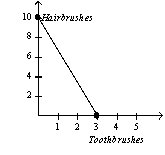
Portugal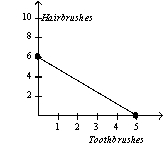
B) Zimbabwe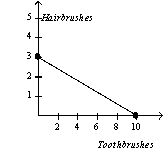
Portugal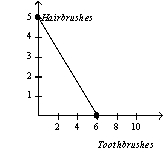
C) Zimbabwe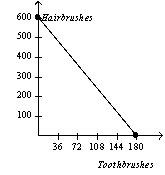
Portugal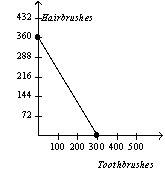
D) Zimbabwe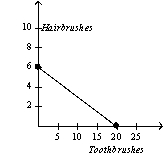
Portugal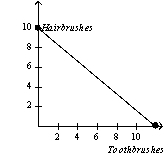
Assume that Zimbabwe and Portugal can switch between producing toothbrushes and producing hairbrushes at a constant rate.

Refer to Table 3-3.Which of the following represents Zimbabwe's and Portugal's production possibilities frontiers when each country has 60 minutes of machine time available?
A) Zimbabwe

Portugal

B) Zimbabwe

Portugal

C) Zimbabwe

Portugal

D) Zimbabwe

Portugal


Unlock Deck
Unlock for access to all 443 flashcards in this deck.
Unlock Deck
k this deck
40
Table 3-5
Assume that England and Spain can switch between producing cheese and producing bread at a constant rate.

Refer to Table 3-5.Which of the following combinations of cheese and bread could England not produce in 40 hours?
A) 5 units of cheese and 9 units of bread.
B) 10 units of cheese and 7.5 units of bread.
C) 20 units of cheese and 5 units of bread.
D) 30 units of cheese and 2.5 units of bread.
Assume that England and Spain can switch between producing cheese and producing bread at a constant rate.

Refer to Table 3-5.Which of the following combinations of cheese and bread could England not produce in 40 hours?
A) 5 units of cheese and 9 units of bread.
B) 10 units of cheese and 7.5 units of bread.
C) 20 units of cheese and 5 units of bread.
D) 30 units of cheese and 2.5 units of bread.

Unlock Deck
Unlock for access to all 443 flashcards in this deck.
Unlock Deck
k this deck
41
Table 3-8
Assume that Huang and Min can switch between producing parasols and producing porcelain plates at a constant rate.

Refer to Table 3-8.Assume that Huang and Min each has 36 labor hours available.If each person divides his/her time equally between the production of parasols and plates,then total production is
A) 18 parasols and 6 plates.
B) 18 parasols and 7.5 plates.
C) 16 parasols and 12 plates.
D) 36 parasols and 15 plates.
Assume that Huang and Min can switch between producing parasols and producing porcelain plates at a constant rate.

Refer to Table 3-8.Assume that Huang and Min each has 36 labor hours available.If each person divides his/her time equally between the production of parasols and plates,then total production is
A) 18 parasols and 6 plates.
B) 18 parasols and 7.5 plates.
C) 16 parasols and 12 plates.
D) 36 parasols and 15 plates.

Unlock Deck
Unlock for access to all 443 flashcards in this deck.
Unlock Deck
k this deck
42
Table 3-6
Assume that Maya and Miguel can switch between producing mixers and producing toasters at a constant rate.

Refer to Table 3-6.We could use the information in the table to draw a production possibilities frontier for Maya and a second production possibilities frontier for Miguel.If we were to do this,measuring mixers along the horizontal axis,then
A) the slope of Maya's production possibilities frontier would be -1.6 and the slope of Miguel's production possibilities frontier would be -2.
B) the slope of Maya's production possibilities frontier would be -0.625 and the slope of Miguel's production possibilities frontier would be -0.5.
C) the slope of Maya's production possibilities frontier would be 0.625 and the slope of Miguel's production possibilities frontier would be 0.5.
D) the slope of Maya's production possibilities frontier would be 1.6 and the slope of Miguel's production possibilities frontier would be 2.
Assume that Maya and Miguel can switch between producing mixers and producing toasters at a constant rate.

Refer to Table 3-6.We could use the information in the table to draw a production possibilities frontier for Maya and a second production possibilities frontier for Miguel.If we were to do this,measuring mixers along the horizontal axis,then
A) the slope of Maya's production possibilities frontier would be -1.6 and the slope of Miguel's production possibilities frontier would be -2.
B) the slope of Maya's production possibilities frontier would be -0.625 and the slope of Miguel's production possibilities frontier would be -0.5.
C) the slope of Maya's production possibilities frontier would be 0.625 and the slope of Miguel's production possibilities frontier would be 0.5.
D) the slope of Maya's production possibilities frontier would be 1.6 and the slope of Miguel's production possibilities frontier would be 2.

Unlock Deck
Unlock for access to all 443 flashcards in this deck.
Unlock Deck
k this deck
43
Table 3-12

Refer to Table 3-12.Which of the following combinations of meat and potatoes could the rancher not produce in 40 hours?
A) 2 pounds of meat and 3 pounds of potatoes.
B) 3 pounds of meat and 3 pounds of potatoes.
C) 4 pounds of meat and 2 pounds of potatoes.
D) 5 pounds of meat and 2 pound of potatoes.

Refer to Table 3-12.Which of the following combinations of meat and potatoes could the rancher not produce in 40 hours?
A) 2 pounds of meat and 3 pounds of potatoes.
B) 3 pounds of meat and 3 pounds of potatoes.
C) 4 pounds of meat and 2 pounds of potatoes.
D) 5 pounds of meat and 2 pound of potatoes.

Unlock Deck
Unlock for access to all 443 flashcards in this deck.
Unlock Deck
k this deck
44
Table 3-11
Assume that Falda and Varick can switch between producing wheat and producing cloth at a constant rate.

Refer to Table 3-11.Falda's opportunity cost of one bushel of wheat is
A) 2/3 yard of cloth and Varick's opportunity cost of one bushel of wheat is 2/5 yard of cloth.
B) 2/3 yard of cloth and Varick's opportunity cost of one bushel of wheat is 5/2 yards of cloth.
C) 3/2 yards of cloth and Varick's opportunity cost of one bushel of wheat is 2/5 yard of cloth.
D) 3/2 yards of cloth and Varick's opportunity cost of one bushel of wheat is 5/2 yards of cloth.
Assume that Falda and Varick can switch between producing wheat and producing cloth at a constant rate.

Refer to Table 3-11.Falda's opportunity cost of one bushel of wheat is
A) 2/3 yard of cloth and Varick's opportunity cost of one bushel of wheat is 2/5 yard of cloth.
B) 2/3 yard of cloth and Varick's opportunity cost of one bushel of wheat is 5/2 yards of cloth.
C) 3/2 yards of cloth and Varick's opportunity cost of one bushel of wheat is 2/5 yard of cloth.
D) 3/2 yards of cloth and Varick's opportunity cost of one bushel of wheat is 5/2 yards of cloth.

Unlock Deck
Unlock for access to all 443 flashcards in this deck.
Unlock Deck
k this deck
45
Table 3-11
Assume that Falda and Varick can switch between producing wheat and producing cloth at a constant rate.

Refer to Table 3-11.Falda's opportunity cost of one yard of cloth is
A) 2/3 bushel of wheat and Varick's opportunity cost of one yard of cloth is 2/5 bushel of wheat.
B) 2/3 bushel of wheat and Varick's opportunity cost of one yard of cloth is 5/2 bushels of wheat.
C) 3/2 bushels of wheat and Varick's opportunity cost of one yard of cloth is 2/5 bushel of wheat.
D) 3/2 bushels of wheat and Varick's opportunity cost of one yard of cloth is 5/2 bushels of wheat.
Assume that Falda and Varick can switch between producing wheat and producing cloth at a constant rate.

Refer to Table 3-11.Falda's opportunity cost of one yard of cloth is
A) 2/3 bushel of wheat and Varick's opportunity cost of one yard of cloth is 2/5 bushel of wheat.
B) 2/3 bushel of wheat and Varick's opportunity cost of one yard of cloth is 5/2 bushels of wheat.
C) 3/2 bushels of wheat and Varick's opportunity cost of one yard of cloth is 2/5 bushel of wheat.
D) 3/2 bushels of wheat and Varick's opportunity cost of one yard of cloth is 5/2 bushels of wheat.

Unlock Deck
Unlock for access to all 443 flashcards in this deck.
Unlock Deck
k this deck
46
Table 3-12

Refer to Table 3-12.Assume that the farmer and the rancher each has 40 labor hours available.If each person divides his time equally between the production of meat and potatoes,then total production is
A) 5 pounds of meat and 4 pounds of potatoes.
B) 6 pounds of meat and 7.5 pounds of potatoes.
C) 7.5 pounds of meat and 6 pounds of potatoes.
D) 10 pounds of meat and 8 pounds of potatoes.

Refer to Table 3-12.Assume that the farmer and the rancher each has 40 labor hours available.If each person divides his time equally between the production of meat and potatoes,then total production is
A) 5 pounds of meat and 4 pounds of potatoes.
B) 6 pounds of meat and 7.5 pounds of potatoes.
C) 7.5 pounds of meat and 6 pounds of potatoes.
D) 10 pounds of meat and 8 pounds of potatoes.

Unlock Deck
Unlock for access to all 443 flashcards in this deck.
Unlock Deck
k this deck
47
Table 3-8
Assume that Huang and Min can switch between producing parasols and producing porcelain plates at a constant rate.

Refer to Table 3-8.Which of the following points would be on Min's production possibilities frontier,based on a 36-hour production period?
A) (3 parasols, 8 plates)
B) (8 parasols, 5 plates)
C) (11 parasols, 4 plates)
D) More than one of the above would be on Min's production possibilities frontier.
Assume that Huang and Min can switch between producing parasols and producing porcelain plates at a constant rate.

Refer to Table 3-8.Which of the following points would be on Min's production possibilities frontier,based on a 36-hour production period?
A) (3 parasols, 8 plates)
B) (8 parasols, 5 plates)
C) (11 parasols, 4 plates)
D) More than one of the above would be on Min's production possibilities frontier.

Unlock Deck
Unlock for access to all 443 flashcards in this deck.
Unlock Deck
k this deck
48
Table 3-7
Assume that Japan and Korea can switch between producing cars and producing airplanes at a constant rate.

Refer to Table 3-7.We could use the information in the table to draw a production possibilities frontier for Japan and a second production possibilities frontier for Korea.If we were to do this,measuring airplanes along the horizontal axis,then
A) the slope of Japan's production possibilities frontier would be -5 and the slope of Korea's production possibilities frontier would be -3.
B) the slope of Japan's production possibilities frontier would be -0.2 and the slope of Korea's production possibilities frontier would be -0.33.
C) the slope of Japan's production possibilities frontier would be 0.2 and the slope of Korea's production possibilities frontier would be 0.33.
D) the slope of Japan's production possibilities frontier would be 5 and the slope of Korea's production possibilities frontier would be 3.
Assume that Japan and Korea can switch between producing cars and producing airplanes at a constant rate.

Refer to Table 3-7.We could use the information in the table to draw a production possibilities frontier for Japan and a second production possibilities frontier for Korea.If we were to do this,measuring airplanes along the horizontal axis,then
A) the slope of Japan's production possibilities frontier would be -5 and the slope of Korea's production possibilities frontier would be -3.
B) the slope of Japan's production possibilities frontier would be -0.2 and the slope of Korea's production possibilities frontier would be -0.33.
C) the slope of Japan's production possibilities frontier would be 0.2 and the slope of Korea's production possibilities frontier would be 0.33.
D) the slope of Japan's production possibilities frontier would be 5 and the slope of Korea's production possibilities frontier would be 3.

Unlock Deck
Unlock for access to all 443 flashcards in this deck.
Unlock Deck
k this deck
49
Table 3-9
Barb and Jim run a business that sets up and tests computers. Assume that Barb and Jim can switch between setting up and testing computers at a constant rate. The following table applies.

Refer to Table 3-9.Which of the following points would not be on Jim's production possibilities frontier,based on a 40-hour week?
A) (0 computers set up, 60 computers tested)
B) (40 computers set up, 30 computers tested)
C) (60 computers set up, 12 computers tested)
D) (72 computers set up, 6 computers tested)
Barb and Jim run a business that sets up and tests computers. Assume that Barb and Jim can switch between setting up and testing computers at a constant rate. The following table applies.

Refer to Table 3-9.Which of the following points would not be on Jim's production possibilities frontier,based on a 40-hour week?
A) (0 computers set up, 60 computers tested)
B) (40 computers set up, 30 computers tested)
C) (60 computers set up, 12 computers tested)
D) (72 computers set up, 6 computers tested)

Unlock Deck
Unlock for access to all 443 flashcards in this deck.
Unlock Deck
k this deck
50
Table 3-8
Assume that Huang and Min can switch between producing parasols and producing porcelain plates at a constant rate.

Refer to Table 3-8.Which of the following points would not be on Huang's production possibilities frontier,based on a 36-hour production period?
A) (18 parasols, 0 plates)
B) (12 parasols, 2 plates)
C) (6 parasols, 4 plates)
D) (2 parasols, 6 plates)
Assume that Huang and Min can switch between producing parasols and producing porcelain plates at a constant rate.

Refer to Table 3-8.Which of the following points would not be on Huang's production possibilities frontier,based on a 36-hour production period?
A) (18 parasols, 0 plates)
B) (12 parasols, 2 plates)
C) (6 parasols, 4 plates)
D) (2 parasols, 6 plates)

Unlock Deck
Unlock for access to all 443 flashcards in this deck.
Unlock Deck
k this deck
51
Table 3-10
Juanita and Shantala run a business that programs and tests cellular phones. Assume that Juanita and Shantala can switch between programming and testing cellular phones at a constant rate. The following table applies.

Refer to Table 3-10.Which of the following points would be on Juanita's production possibilities frontier,based on a 40-hour week?
A) (120 cellular phones programmed, 295 cellular phones tested)
B) (130 cellular phones programmed, 225 cellular phones tested)
C) (140 cellular phones programmed, 155 cellular phones tested)
D) Both (a) and (b) would be on Juanita's production possibilities frontier.
Juanita and Shantala run a business that programs and tests cellular phones. Assume that Juanita and Shantala can switch between programming and testing cellular phones at a constant rate. The following table applies.

Refer to Table 3-10.Which of the following points would be on Juanita's production possibilities frontier,based on a 40-hour week?
A) (120 cellular phones programmed, 295 cellular phones tested)
B) (130 cellular phones programmed, 225 cellular phones tested)
C) (140 cellular phones programmed, 155 cellular phones tested)
D) Both (a) and (b) would be on Juanita's production possibilities frontier.

Unlock Deck
Unlock for access to all 443 flashcards in this deck.
Unlock Deck
k this deck
52
Table 3-10
Juanita and Shantala run a business that programs and tests cellular phones. Assume that Juanita and Shantala can switch between programming and testing cellular phones at a constant rate. The following table applies.

Refer to Table 3-10.Which of the following points would be on Shantala's production possibilities frontier,based on a 40-hour week?
A) (120 cellular phones programmed, 250 cellular phones tested)
B) (180 cellular phones programmed, 150 cellular phones tested)
C) (240 cellular phones programmed, 600 cellular phones tested)
D) More than one of the above would be on Shantala's production possibilities frontier.
Juanita and Shantala run a business that programs and tests cellular phones. Assume that Juanita and Shantala can switch between programming and testing cellular phones at a constant rate. The following table applies.

Refer to Table 3-10.Which of the following points would be on Shantala's production possibilities frontier,based on a 40-hour week?
A) (120 cellular phones programmed, 250 cellular phones tested)
B) (180 cellular phones programmed, 150 cellular phones tested)
C) (240 cellular phones programmed, 600 cellular phones tested)
D) More than one of the above would be on Shantala's production possibilities frontier.

Unlock Deck
Unlock for access to all 443 flashcards in this deck.
Unlock Deck
k this deck
53
Table 3-7
Assume that Japan and Korea can switch between producing cars and producing airplanes at a constant rate.

Refer to Table 3-7.Assume that Japan and Korea each has 2400 hours available.If each country divides its time equally between the production of cars and airplanes,then total production is
A) 40 cars and 8 airplanes.
B) 64 cars and 16 airplanes.
C) 80 cars and 16 airplanes.
D) 128 cars and 32 airplanes.
Assume that Japan and Korea can switch between producing cars and producing airplanes at a constant rate.

Refer to Table 3-7.Assume that Japan and Korea each has 2400 hours available.If each country divides its time equally between the production of cars and airplanes,then total production is
A) 40 cars and 8 airplanes.
B) 64 cars and 16 airplanes.
C) 80 cars and 16 airplanes.
D) 128 cars and 32 airplanes.

Unlock Deck
Unlock for access to all 443 flashcards in this deck.
Unlock Deck
k this deck
54
Table 3-10
Juanita and Shantala run a business that programs and tests cellular phones. Assume that Juanita and Shantala can switch between programming and testing cellular phones at a constant rate. The following table applies.

Refer to Table 3-10.The number of minutes needed by Juanita to program a cellular phone is
A) 4.
B) 5.
C) 7.5.
D) 15.
Juanita and Shantala run a business that programs and tests cellular phones. Assume that Juanita and Shantala can switch between programming and testing cellular phones at a constant rate. The following table applies.

Refer to Table 3-10.The number of minutes needed by Juanita to program a cellular phone is
A) 4.
B) 5.
C) 7.5.
D) 15.

Unlock Deck
Unlock for access to all 443 flashcards in this deck.
Unlock Deck
k this deck
55
Table 3-7
Assume that Japan and Korea can switch between producing cars and producing airplanes at a constant rate.

Refer to Table 3-7.We could use the information in the table to draw a production possibilities frontier for Japan and a second production possibilities frontier for Korea.If we were to do this,measuring cars along the horizontal axis,then
A) the slope of Japan's production possibilities frontier would be -5 and the slope of Korea's production possibilities frontier would be -3.
B) the slope of Japan's production possibilities frontier would be -0.2 and the slope of Korea's production possibilities frontier would be -0.33.
C) the slope of Japan's production possibilities frontier would be 0.2 and the slope of Korea's production possibilities frontier would be 0.33.
D) the slope of Japan's production possibilities frontier would be 5 and the slope of Korea's production possibilities frontier would be 3.
Assume that Japan and Korea can switch between producing cars and producing airplanes at a constant rate.

Refer to Table 3-7.We could use the information in the table to draw a production possibilities frontier for Japan and a second production possibilities frontier for Korea.If we were to do this,measuring cars along the horizontal axis,then
A) the slope of Japan's production possibilities frontier would be -5 and the slope of Korea's production possibilities frontier would be -3.
B) the slope of Japan's production possibilities frontier would be -0.2 and the slope of Korea's production possibilities frontier would be -0.33.
C) the slope of Japan's production possibilities frontier would be 0.2 and the slope of Korea's production possibilities frontier would be 0.33.
D) the slope of Japan's production possibilities frontier would be 5 and the slope of Korea's production possibilities frontier would be 3.

Unlock Deck
Unlock for access to all 443 flashcards in this deck.
Unlock Deck
k this deck
56
Table 3-9
Barb and Jim run a business that sets up and tests computers. Assume that Barb and Jim can switch between setting up and testing computers at a constant rate. The following table applies.

Refer to Table 3-9.The number of minutes needed by Barb to test a computer is
A) 36.
B) 48.
C) 60.
D) 64.
Barb and Jim run a business that sets up and tests computers. Assume that Barb and Jim can switch between setting up and testing computers at a constant rate. The following table applies.

Refer to Table 3-9.The number of minutes needed by Barb to test a computer is
A) 36.
B) 48.
C) 60.
D) 64.

Unlock Deck
Unlock for access to all 443 flashcards in this deck.
Unlock Deck
k this deck
57
Table 3-11
Assume that Falda and Varick can switch between producing wheat and producing cloth at a constant rate.

Refer to Table 3-11.Assume that Falda and Varick each has 1 hour available.If each person divides his time equally between the production of wheat and cloth,then total production is
A) 4 bushels of wheat and 7.5 yards of cloth.
B) 7 bushels of wheat and 13.5 yards of cloth.
C) 8 bushels of wheat and 15 yards of cloth.
D) 14 bushels of wheat and 27 yards of cloth.
Assume that Falda and Varick can switch between producing wheat and producing cloth at a constant rate.

Refer to Table 3-11.Assume that Falda and Varick each has 1 hour available.If each person divides his time equally between the production of wheat and cloth,then total production is
A) 4 bushels of wheat and 7.5 yards of cloth.
B) 7 bushels of wheat and 13.5 yards of cloth.
C) 8 bushels of wheat and 15 yards of cloth.
D) 14 bushels of wheat and 27 yards of cloth.

Unlock Deck
Unlock for access to all 443 flashcards in this deck.
Unlock Deck
k this deck
58
Table 3-6
Assume that Maya and Miguel can switch between producing mixers and producing toasters at a constant rate.

Refer to Table 3-6.We could use the information in the table to draw a production possibilities frontier for Maya and a second production possibilities frontier for Miguel.If we were to do this,measuring toasters along the horizontal axis,then
A) the slope of Maya's production possibilities frontier would be -1.6 and the slope of Miguel's production possibilities frontier would be -2.
B) the slope of Maya's production possibilities frontier would be -0.625 and the slope of Miguel's production possibilities frontier would be -0.5.
C) the slope of Maya's production possibilities frontier would be 0.625 and the slope of Miguel's production possibilities frontier would be 0.5.
D) the slope of Maya's production possibilities frontier would be 1.6 and the slope of Miguel's production possibilities frontier would be 2.
Assume that Maya and Miguel can switch between producing mixers and producing toasters at a constant rate.

Refer to Table 3-6.We could use the information in the table to draw a production possibilities frontier for Maya and a second production possibilities frontier for Miguel.If we were to do this,measuring toasters along the horizontal axis,then
A) the slope of Maya's production possibilities frontier would be -1.6 and the slope of Miguel's production possibilities frontier would be -2.
B) the slope of Maya's production possibilities frontier would be -0.625 and the slope of Miguel's production possibilities frontier would be -0.5.
C) the slope of Maya's production possibilities frontier would be 0.625 and the slope of Miguel's production possibilities frontier would be 0.5.
D) the slope of Maya's production possibilities frontier would be 1.6 and the slope of Miguel's production possibilities frontier would be 2.

Unlock Deck
Unlock for access to all 443 flashcards in this deck.
Unlock Deck
k this deck
59
Table 3-12

Refer to Table 3-12.Which of the following combinations of meat and potatoes could the farmer produce in 40 hours?
A) 1 pound of meat and 7 pounds of potatoes.
B) 2 pounds of meat and 5 pounds of potatoes.
C) 3 pounds of meat and 3 pounds of potatoes.
D) 4 pounds of meat and 2 pounds of potatoes.

Refer to Table 3-12.Which of the following combinations of meat and potatoes could the farmer produce in 40 hours?
A) 1 pound of meat and 7 pounds of potatoes.
B) 2 pounds of meat and 5 pounds of potatoes.
C) 3 pounds of meat and 3 pounds of potatoes.
D) 4 pounds of meat and 2 pounds of potatoes.

Unlock Deck
Unlock for access to all 443 flashcards in this deck.
Unlock Deck
k this deck
60
Table 3-9
Barb and Jim run a business that sets up and tests computers. Assume that Barb and Jim can switch between setting up and testing computers at a constant rate. The following table applies.

Refer to Table 3-9.Which of the following points would not be on Barb's production possibilities frontier,based on a 40-hour week?
A) (0 computers set up, 40 computers tested)
B) (8 computers set up, 32 computers tested)
C) (25 computers set up, 20 computers tested)
D) (30 computers set up, 16 computers tested)
Barb and Jim run a business that sets up and tests computers. Assume that Barb and Jim can switch between setting up and testing computers at a constant rate. The following table applies.

Refer to Table 3-9.Which of the following points would not be on Barb's production possibilities frontier,based on a 40-hour week?
A) (0 computers set up, 40 computers tested)
B) (8 computers set up, 32 computers tested)
C) (25 computers set up, 20 computers tested)
D) (30 computers set up, 16 computers tested)

Unlock Deck
Unlock for access to all 443 flashcards in this deck.
Unlock Deck
k this deck
61
Figure 3-3

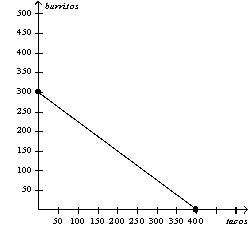

Refer to Figure 3-3.If the production possibilities frontier shown for Arturo is for 100 hours of production,then how long does it take Arturo to make one burrito?
A) 1/4 hour
B) 1/3 hour
C) 3 hours
D) 4 hours



Refer to Figure 3-3.If the production possibilities frontier shown for Arturo is for 100 hours of production,then how long does it take Arturo to make one burrito?
A) 1/4 hour
B) 1/3 hour
C) 3 hours
D) 4 hours

Unlock Deck
Unlock for access to all 443 flashcards in this deck.
Unlock Deck
k this deck
62
Table 3-14
The following table contains some production possibilities for an economy for a given year.

Refer to Table 3-14.If the production possibilities frontier is bowed outward,then "?" could be
A) 340.
B) 330.
C) 320.
D) 310.
The following table contains some production possibilities for an economy for a given year.

Refer to Table 3-14.If the production possibilities frontier is bowed outward,then "?" could be
A) 340.
B) 330.
C) 320.
D) 310.

Unlock Deck
Unlock for access to all 443 flashcards in this deck.
Unlock Deck
k this deck
63
Figure 3-3



Refer to Figure 3-3.If the production possibilities frontiers shown are each for one day of production,then which of the following combinations of tacos and burritos could Arturo and Dina together produce in a given day?
A) 400 tacos and 350 burritos
B) 500 tacos and 250 burritos
C) 600 tacos and 150 burritos
D) 700 tacos and 100 burritos



Refer to Figure 3-3.If the production possibilities frontiers shown are each for one day of production,then which of the following combinations of tacos and burritos could Arturo and Dina together produce in a given day?
A) 400 tacos and 350 burritos
B) 500 tacos and 250 burritos
C) 600 tacos and 150 burritos
D) 700 tacos and 100 burritos

Unlock Deck
Unlock for access to all 443 flashcards in this deck.
Unlock Deck
k this deck
64
Table 3-13
The following table contains some production possibilities for an economy for a given month.

Refer to Table 3-13.If the production possibilities frontier is bowed outward,then "?" could be
A) 100.
B) 150.
C) 200.
D) 250.
The following table contains some production possibilities for an economy for a given month.

Refer to Table 3-13.If the production possibilities frontier is bowed outward,then "?" could be
A) 100.
B) 150.
C) 200.
D) 250.

Unlock Deck
Unlock for access to all 443 flashcards in this deck.
Unlock Deck
k this deck
65
Figure 3-3



Refer to Figure 3-3.If Arturo and Dina both spend all of their time producing tacos,then total production is
A) 400 tacos and 0 burritos.
B) 400 tacos and 250 burritos.
C) 800 tacos and 0 burritos.
D) 800 tacos and 500 burritos.



Refer to Figure 3-3.If Arturo and Dina both spend all of their time producing tacos,then total production is
A) 400 tacos and 0 burritos.
B) 400 tacos and 250 burritos.
C) 800 tacos and 0 burritos.
D) 800 tacos and 500 burritos.

Unlock Deck
Unlock for access to all 443 flashcards in this deck.
Unlock Deck
k this deck
66
Table 3-15
The following table contains some production possibilities for an economy for a given month.

Refer to Table 3-15.If the production possibilities frontier is bowed outward,then "?" could be
A) 50.
B) 75.
C) 100.
D) 125.
The following table contains some production possibilities for an economy for a given month.

Refer to Table 3-15.If the production possibilities frontier is bowed outward,then "?" could be
A) 50.
B) 75.
C) 100.
D) 125.

Unlock Deck
Unlock for access to all 443 flashcards in this deck.
Unlock Deck
k this deck
67
Figure 3-2
Peru's Production Possibilities Frontier
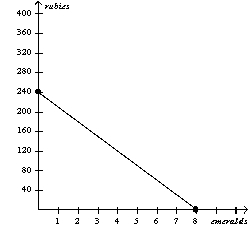
Refer to Figure 3-2.If the production possibilities frontier shown is for one month of production,then which of the following combinations of emeralds and rubies could Peru not produce in a given month?
A) 6 emeralds and 60 rubies
B) 4 emeralds and 120 rubies
C) 3 emeralds and 160 rubies
D) 1 emeralds and 210 rubies
Peru's Production Possibilities Frontier

Refer to Figure 3-2.If the production possibilities frontier shown is for one month of production,then which of the following combinations of emeralds and rubies could Peru not produce in a given month?
A) 6 emeralds and 60 rubies
B) 4 emeralds and 120 rubies
C) 3 emeralds and 160 rubies
D) 1 emeralds and 210 rubies

Unlock Deck
Unlock for access to all 443 flashcards in this deck.
Unlock Deck
k this deck
68
Figure 3-2
Peru's Production Possibilities Frontier

Refer to Figure 3-2.If the production possibilities frontier shown is for 40 hours of production,then how long does it take Peru to make one ruby?
A) 1/6 hour
B) 1/5 hour
C) 5 hours
D) 6 hours
Peru's Production Possibilities Frontier

Refer to Figure 3-2.If the production possibilities frontier shown is for 40 hours of production,then how long does it take Peru to make one ruby?
A) 1/6 hour
B) 1/5 hour
C) 5 hours
D) 6 hours

Unlock Deck
Unlock for access to all 443 flashcards in this deck.
Unlock Deck
k this deck
69
Table 3-13
The following table contains some production possibilities for an economy for a given month.

Refer to Table 3-13.If the production possibilities frontier is a straight line,then "?" must be
A) 100.
B) 150.
C) 200.
D) 250.
The following table contains some production possibilities for an economy for a given month.

Refer to Table 3-13.If the production possibilities frontier is a straight line,then "?" must be
A) 100.
B) 150.
C) 200.
D) 250.

Unlock Deck
Unlock for access to all 443 flashcards in this deck.
Unlock Deck
k this deck
70
Figure 3-3



Refer to Figure 3-3.If the production possibilities frontiers shown are each for one day of production,then which of the following combinations of tacos and burritos could Arturo and Dina together not produce in a given day?
A) 200 tacos and 400 burritos
B) 300 tacos and 350 burritos
C) 400 tacos and 300 burritos
D) 600 tacos and 250 burritos



Refer to Figure 3-3.If the production possibilities frontiers shown are each for one day of production,then which of the following combinations of tacos and burritos could Arturo and Dina together not produce in a given day?
A) 200 tacos and 400 burritos
B) 300 tacos and 350 burritos
C) 400 tacos and 300 burritos
D) 600 tacos and 250 burritos

Unlock Deck
Unlock for access to all 443 flashcards in this deck.
Unlock Deck
k this deck
71
Figure 3-3



Refer to Figure 3-3.If Arturo and Dina each divides his/her time equally between the production of tacos and burritos,then total production is
A) 200 tacos and 150 burritos.
B) 400 tacos and 250 burritos.
C) 400 tacos and 300 burritos.
D) 800 tacos and 500 burritos.



Refer to Figure 3-3.If Arturo and Dina each divides his/her time equally between the production of tacos and burritos,then total production is
A) 200 tacos and 150 burritos.
B) 400 tacos and 250 burritos.
C) 400 tacos and 300 burritos.
D) 800 tacos and 500 burritos.

Unlock Deck
Unlock for access to all 443 flashcards in this deck.
Unlock Deck
k this deck
72
Table 3-16 Summary of the Gains from Trade

Refer to Table 3-16.The values in the table represent the amounts of lemonade and pizzas that Alice and Betty can produce in one week without and with specialization and trade.What are Alice and Betty's gains from specialization and trade?
A) Alice gains 7 pitchers of lemonade and 10 pizzas, while Betty gains 13 pitchers of lemonade and 10 pizzas.
B) Alice gains 200 pitchers of lemonade and 100 pizzas, while Betty gains 180 pitchers of lemonade and 180 pizzas.
C) Alice gains 207 pitchers of lemonade and 110 pizzas, while Betty gains 193 pitchers of lemonade and 190 pizzas.
D) Alice gains 400 pitchers of lemonade and 0 pizzas, while Betty gains 0 pitchers of lemonade and 300 pizzas.

Refer to Table 3-16.The values in the table represent the amounts of lemonade and pizzas that Alice and Betty can produce in one week without and with specialization and trade.What are Alice and Betty's gains from specialization and trade?
A) Alice gains 7 pitchers of lemonade and 10 pizzas, while Betty gains 13 pitchers of lemonade and 10 pizzas.
B) Alice gains 200 pitchers of lemonade and 100 pizzas, while Betty gains 180 pitchers of lemonade and 180 pizzas.
C) Alice gains 207 pitchers of lemonade and 110 pizzas, while Betty gains 193 pitchers of lemonade and 190 pizzas.
D) Alice gains 400 pitchers of lemonade and 0 pizzas, while Betty gains 0 pitchers of lemonade and 300 pizzas.

Unlock Deck
Unlock for access to all 443 flashcards in this deck.
Unlock Deck
k this deck
73
Figure 3-2
Peru's Production Possibilities Frontier

Refer to Figure 3-2.The fact that the line slopes downward reflects the fact that
A) for Peru, it is more costly to produce emeralds than it is to produce rubies.
B) Peru will produce more emeralds and fewer rubies as time goes by.
C) Peru faces a tradeoff between producing emeralds and producing rubies.
D) Peru should specialize in producing rubies.
Peru's Production Possibilities Frontier

Refer to Figure 3-2.The fact that the line slopes downward reflects the fact that
A) for Peru, it is more costly to produce emeralds than it is to produce rubies.
B) Peru will produce more emeralds and fewer rubies as time goes by.
C) Peru faces a tradeoff between producing emeralds and producing rubies.
D) Peru should specialize in producing rubies.

Unlock Deck
Unlock for access to all 443 flashcards in this deck.
Unlock Deck
k this deck
74
Table 3-15
The following table contains some production possibilities for an economy for a given month.

Refer to Table 3-15.If the production possibilities frontier is a straight line,then "?" must be
A) 50.
B) 75.
C) 100.
D) 125.
The following table contains some production possibilities for an economy for a given month.

Refer to Table 3-15.If the production possibilities frontier is a straight line,then "?" must be
A) 50.
B) 75.
C) 100.
D) 125.

Unlock Deck
Unlock for access to all 443 flashcards in this deck.
Unlock Deck
k this deck
75
Figure 3-1

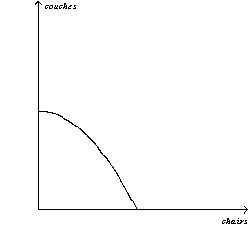
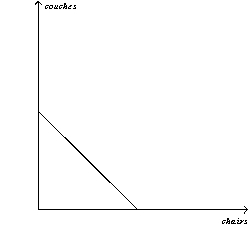
Refer to Figure 3-1.The rate of tradeoff between producing chairs and producing couches is constant in
A) Panel (a).
B) Panel (b).
C) both Panel (a) and Panel (b).
D) neither Panel (a) nor Panel (b).



Refer to Figure 3-1.The rate of tradeoff between producing chairs and producing couches is constant in
A) Panel (a).
B) Panel (b).
C) both Panel (a) and Panel (b).
D) neither Panel (a) nor Panel (b).

Unlock Deck
Unlock for access to all 443 flashcards in this deck.
Unlock Deck
k this deck
76
Figure 3-3



Refer to Figure 3-3.If Dina must work 0.25 hour to produce each taco,then her production possibilities frontier is based on how many hours of work?
A) 40 hours
B) 100 hours
C) 400 hours
D) 1600 hours



Refer to Figure 3-3.If Dina must work 0.25 hour to produce each taco,then her production possibilities frontier is based on how many hours of work?
A) 40 hours
B) 100 hours
C) 400 hours
D) 1600 hours

Unlock Deck
Unlock for access to all 443 flashcards in this deck.
Unlock Deck
k this deck
77
Figure 3-1



Refer to Figure 3-1.The rate of tradeoff between producing chairs and producing couches depends on how many chairs and couches are being produced in
A) Panel (a).
B) Panel (b).
C) both Panel (a) and Panel (b).
D) neither Panel (a) nor Panel (b).



Refer to Figure 3-1.The rate of tradeoff between producing chairs and producing couches depends on how many chairs and couches are being produced in
A) Panel (a).
B) Panel (b).
C) both Panel (a) and Panel (b).
D) neither Panel (a) nor Panel (b).

Unlock Deck
Unlock for access to all 443 flashcards in this deck.
Unlock Deck
k this deck
78
Table 3-14
The following table contains some production possibilities for an economy for a given year.

Refer to Table 3-14.If the production possibilities frontier is a straight line,then "?" must be
A) 340.
B) 330.
C) 320.
D) 310.
The following table contains some production possibilities for an economy for a given year.

Refer to Table 3-14.If the production possibilities frontier is a straight line,then "?" must be
A) 340.
B) 330.
C) 320.
D) 310.

Unlock Deck
Unlock for access to all 443 flashcards in this deck.
Unlock Deck
k this deck
79
Figure 3-2
Peru's Production Possibilities Frontier

Refer to Figure 3-2.If the production possibilities frontier shown is for one month of production,then which of the following combinations of emeralds and rubies could Peru produce in a given month?
A) 7 emeralds and 40 rubies
B) 5 emeralds and 92 rubies
C) 3 emeralds and 165 rubies
D) 2 emeralds and 180 rubies
Peru's Production Possibilities Frontier

Refer to Figure 3-2.If the production possibilities frontier shown is for one month of production,then which of the following combinations of emeralds and rubies could Peru produce in a given month?
A) 7 emeralds and 40 rubies
B) 5 emeralds and 92 rubies
C) 3 emeralds and 165 rubies
D) 2 emeralds and 180 rubies

Unlock Deck
Unlock for access to all 443 flashcards in this deck.
Unlock Deck
k this deck
80
Figure 3-2
Peru's Production Possibilities Frontier

Refer to Figure 3-2.If the production possibilities frontier shown is for 40 hours of production,then how long does it take Peru to make one emerald?
A) 1/6 hour
B) 1/5 hour
C) 5 hours
D) 6 hours
Peru's Production Possibilities Frontier

Refer to Figure 3-2.If the production possibilities frontier shown is for 40 hours of production,then how long does it take Peru to make one emerald?
A) 1/6 hour
B) 1/5 hour
C) 5 hours
D) 6 hours

Unlock Deck
Unlock for access to all 443 flashcards in this deck.
Unlock Deck
k this deck



